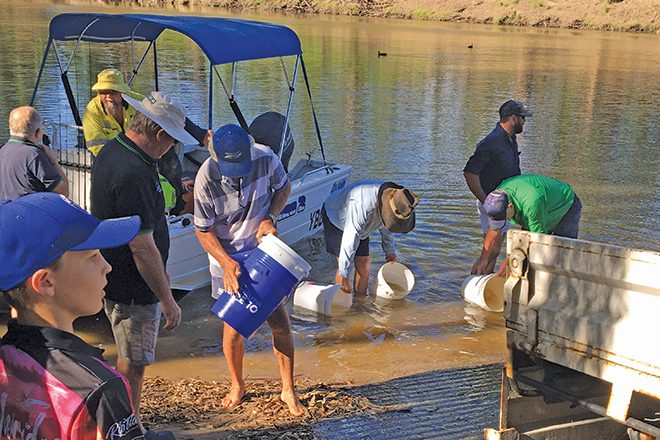On the second Sunday in February, the Goondiwindi Fish Restockers took delivery of 40,000 yellowbelly fingerlings.
This took the total for 2022 to 160,000 all up.
The club wishes to thank those who supplied boats, manned buckets, the Hanwood Fish Hatchery, the Granite Belt Fish Hatchery as well as Braddy and the staff from the Railway Hotel, and to all our supporters who buy tickets every Friday night at the Railway Hotel.
Thanks also to the Vern Kleinschmidt Community Trust and Queensland Fisheries for their donations.
We are truly thankful for all your help. Goondiwindi Fish Restockers
About fish restocking in Queensland
Effective management of stocked fisheries resources depends on appropriate legislation, policies, compliance, communication, stocking group partnerships, hatchery production of fingerlings and periodic review of management.
Stocking is a use of fisheries resources that, if managed appropriately, aligns with the purposes of the Fisheries Act in terms of providing benefits to the wider community while minimising environmental risks.
It also supports the priorities of Queensland’s ‘Our Future State’ plan to advance Queensland. More than 50 million fish have been stocked into freshwater dams, weirs, rivers and creeks throughout Queensland since 1974. Stocking activities have evolved and expanded into sophisticated operations that focus on the best management and use of the state’s freshwater fisheries resources. Fish stocking can provide great environmental, social, cultural, and economic benefits, including:
- industry development (such as tourism and recreational fishing)
- employment (e.g. for charter operators, bait and tackle shops, caravan parks etc.)
- investment incentives for hatcheries and associated infrastructure
- contribution to social and cultural values from fishing, food and voluntary activities.
Stocking also provides significant economic benefits to the state. A 2013 study, An economic assessment of the value of recreational angling at Queensland dams involved in the Stocked Impoundment Permit Scheme (Gregg and Rolfe 2013), indicated that the return to regional economies was $100 million annually using the travel–cost method of estimation (this excludes sales of boats, tackle and gear).
Historically, fish stocked into waterways were caught as juveniles and adults and moved between waterways. When mass stocking of fish first began in 1974, fingerlings were sourced from the Queensland Government and from hatcheries in New South Wales. This continued until hatcheries in Queensland became established and were able to fulfil orders for fingerlings.
The position paper Freshwater stocking in Queensland (Moore 2007) was released in 2007 by the Queensland Government for use in the development of future ecologically sustainable management practices. That position paper is superseded by this policy.
An ecological risk assessment completed in 2012 informed most of the current management arrangements and the guidelines in this policy.
The development of a fish stocking policy for all waters in Queensland, including tidal waters, was a key action item from the 2018 Freshwater Fishing and Fish Stocking Workshop held at Warwick. This meeting also highlighted the need to continue to investigate new species for stocking, with jungle perch, mangrove jack and sea mullet identified as species that had the most advanced research and development
 Bush ‘n Beach Fishing Magazine Location reports & tips for fishing, boating, camping, kayaking, 4WDing in Queensland and Northern NSW
Bush ‘n Beach Fishing Magazine Location reports & tips for fishing, boating, camping, kayaking, 4WDing in Queensland and Northern NSW









